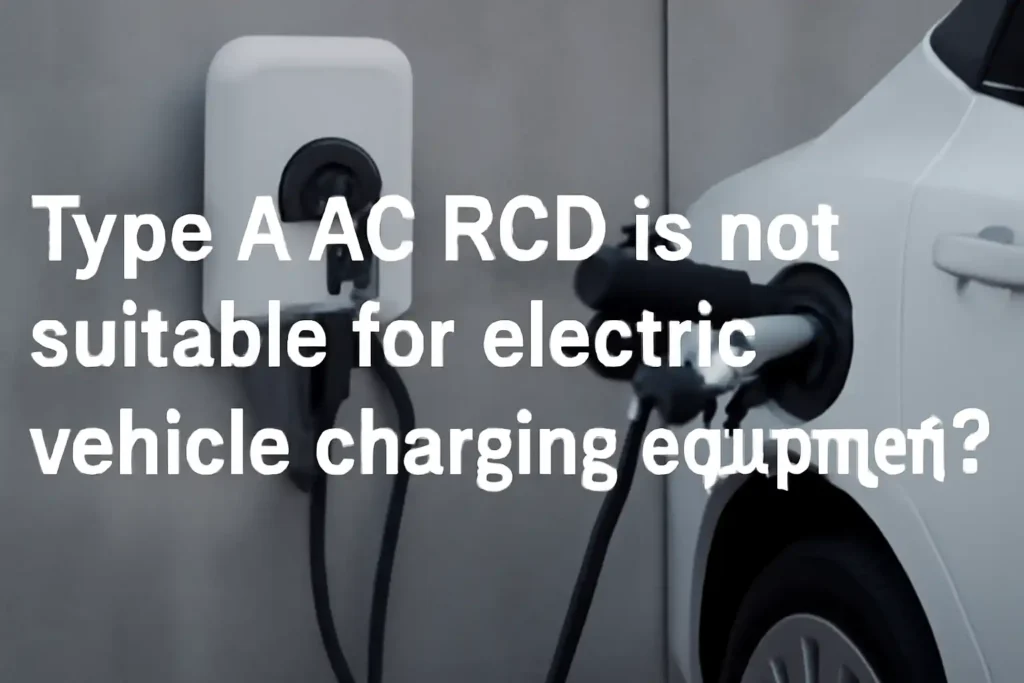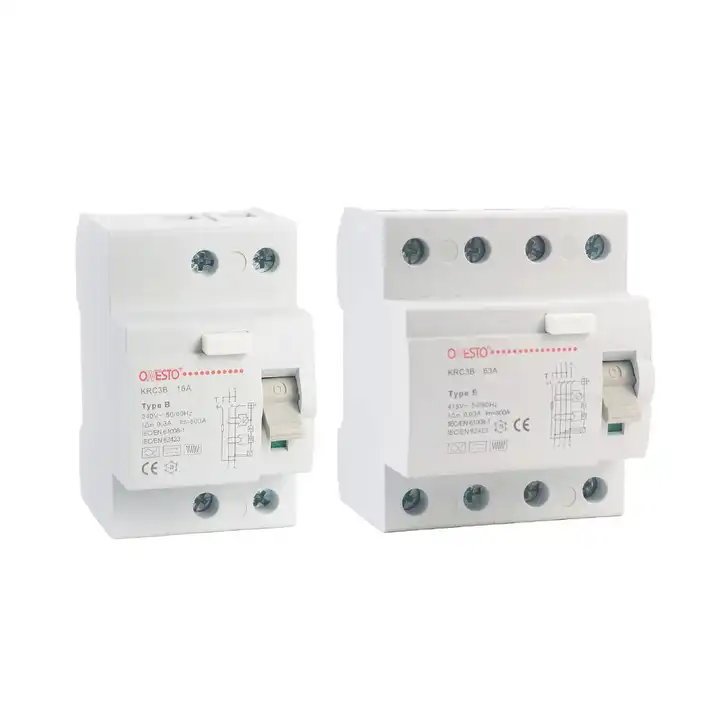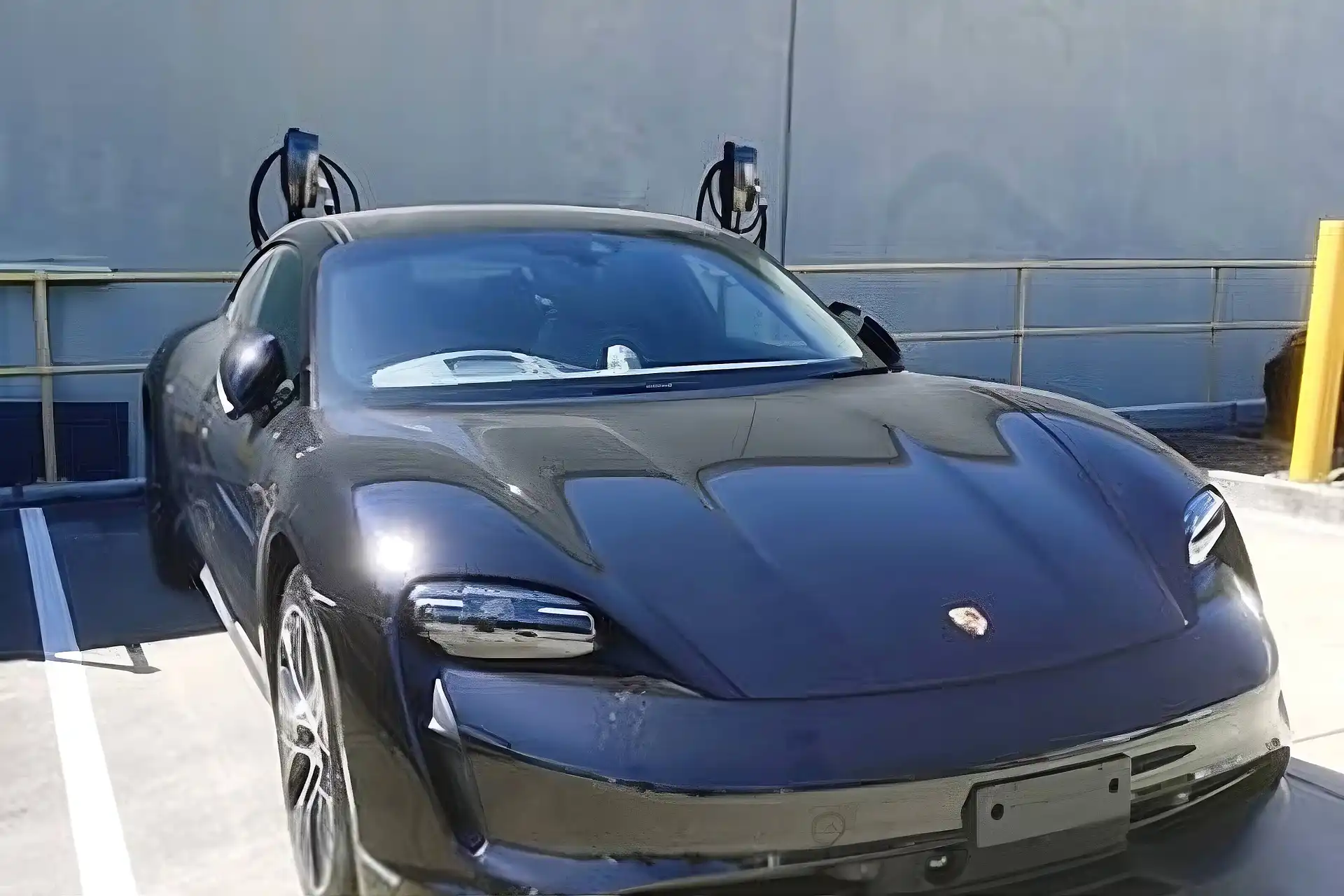When charging an electric car, safety must come first. Type A communication RCDs are not good for this because they can’t sense smooth DC currents. These currents happen often during EV charging and can be dangerous if missed. If not detected, the Type A communication RCD might not work properly, increasing the risk of electric shock. This problem makes Type A communication RCDs a bad option for safe EV charging.
Key Takeaways
- Type A RCDs cannot find smooth DC currents, common in EV charging. This makes them risky to use.
- Type B RCDs are important for EV charging. They detect both AC and DC leaks, making charging safer.
- Many new EV chargers have built-in DC detection. This removes the need for extra RCDs and works faster.
- Following global safety rules like IEC 61851 is key. It keeps EV charging systems safe and legal.
- Always check safety features and compatibility when picking an RCD. This protects people and devices.
Understanding RCDs and Their Role in EV Charging
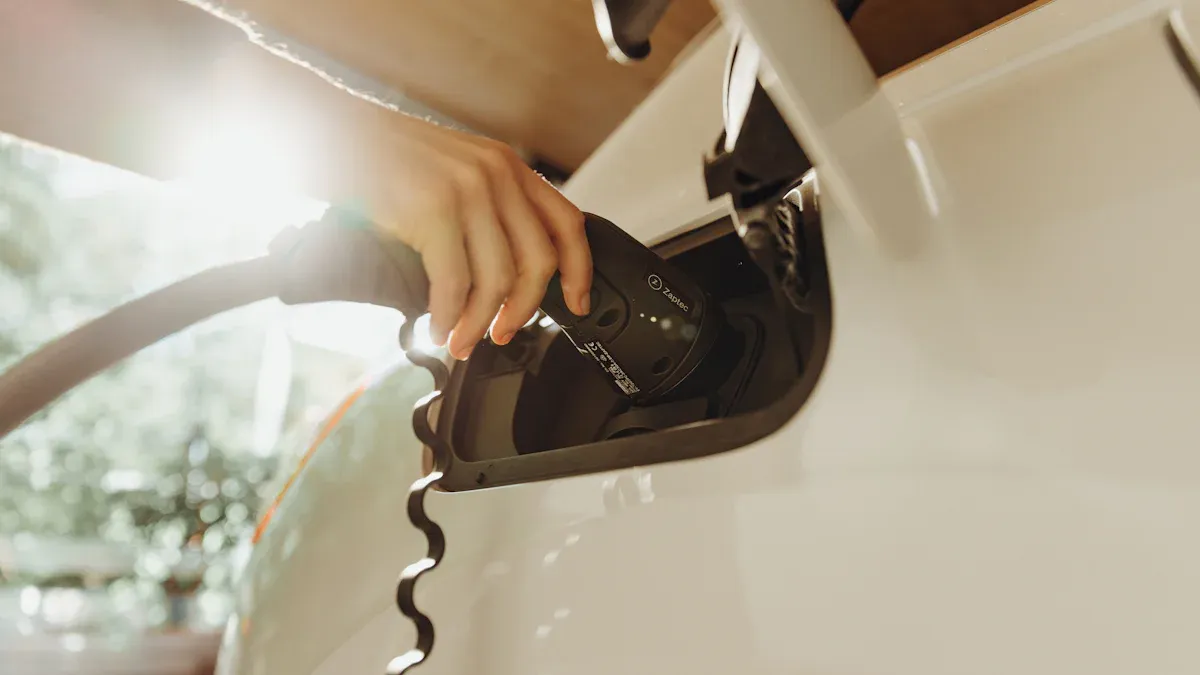
What Are RCDs?
Residual Current Devices (RCDs) are important for electrical safety. They check electricity flow and cut power if there’s a leak. This helps stop electric shocks and prevents fires. RCDs keep the system safe by fixing current problems quickly.
In EV charging, RCDs are very important. Electric cars can create extra currents, like smooth DC currents, while charging. Without a good RCD, these currents might not be noticed, which can be dangerous.
Importance of RCDs in Electric Vehicle Charging
RCDs protect people and equipment during EV charging. They find problems like ground faults or current leaks and fix them fast. This is crucial because EV chargers use high power, which can cause more risks.
Modern EV chargers, such as Easee chargers, have smart RCD features. These chargers test themselves to make sure the RCD works. If there’s a problem, the charger switches to safe mode and sends an alert through an app or on the charger. This makes charging safer and more reliable.
Here’s a simple table of safety tools in EV charging systems:
| Safety Tool | What It Does |
|---|---|
| Residual Current Devices (RCDs) | Watches electricity flow and stops leaks |
| Surge Protection Systems | Stops damage from sudden voltage spikes |
| Temperature Monitoring Sensors | Warns if things get too hot |
| Emergency Power Disconnection Switches | Cuts power quickly in emergencies |
| Ground Fault Circuit Interrupters (GFCIs) | Stops shocks by breaking the circuit |
Safety Standards for EV Charging Equipment
Global safety rules make sure EV chargers are safe to use. For example, IEC 61851 requires protection from 6mA smooth DC and 30mA AC currents. These rules help companies design safer chargers.
Different charging types need specific RCDs. For example:
| Charging Type | Needed RCD Type | Max Current Allowed | Extra Info |
|---|---|---|---|
| Mode 1 & 2 | Type A | 30 mA or less | Installed at outlet or main power box |
| Mode 3 | Type A, F, or B | 30 mA or less | For circuits like 7 kW or 22 kW chargers |
| Mode 4 | Type A, F, or B | 30 mA or less | Fast charging, no RCD needed on DC side |
Following these rules keeps your EV charging setup safe and legal.
Limitations of Type A Communication RCDs
Trouble Detecting Smooth DC Currents
Type A RCDs find AC currents but miss smooth DC currents. This is a big problem for EV charging, where smooth DC currents are common. If these currents are missed, the RCD won’t trip, causing safety risks.
Tests show Type A RCDs lose accuracy with more DC currents. For example:
- At 30 mA DC, the RCD needs over 30 mA AC to trip.
- This proves Type A RCDs can’t handle high smooth DC currents.
Type B RCDs are better for smooth DC currents. They detect and fix problems faster, keeping systems safer.
Dangers of RCD Blinding in Faults
RCD blinding happens when DC currents stop an RCD from working. This is risky in EV charging, where smooth DC currents are frequent. A blinded RCD won’t trip during faults, raising chances of shocks or fires.
Examples show how RCD blinding is dangerous:
- Dual RCD setups often fail during faults.
- DC currents can blind RCDs, making them miss problems.
- Experts suggest using one RCD per charging point to avoid this.
Using Type A RCDs increases these risks. Switching to Type B RCDs, which resist DC blinding, makes charging safer.
Failing EV Charging Safety Rules
Type A RCDs don’t meet strict EV charging safety rules. Standards like IEC 61851 require protection from 6 mA smooth DC currents. Type A RCDs can’t provide this, making them unfit for EV chargers.
Industry studies show why Type A RCDs fall short:
- They can’t detect earth faults with high DC currents, common in EV charging.
- Only advanced RCDs, like Type B, can handle these faults well.
Not following safety rules increases risks and breaks laws. Choosing the right RCD, like Type B, ensures safety and meets legal standards.
The Role of Smooth DC Residual Currents in EV Charging
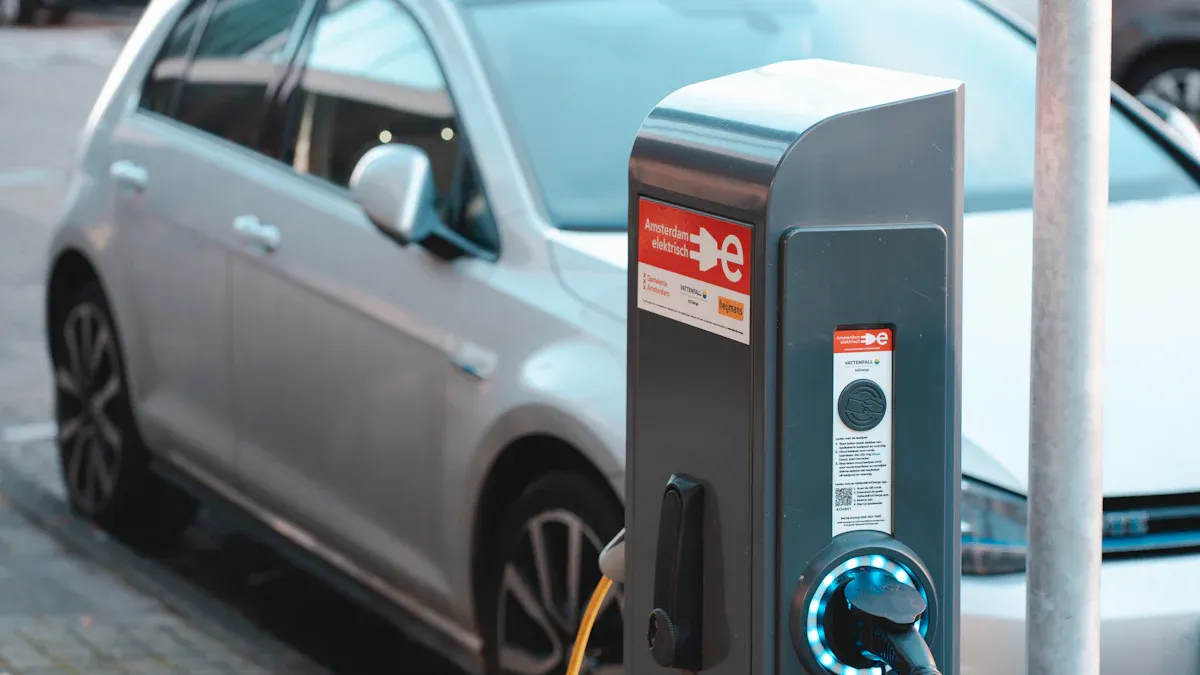
How EV Chargers Create Smooth DC Currents
EV chargers often make smooth DC currents while working. They use special parts like rectifiers and inverters to change AC power into DC power for the car battery. These parts can cause DC currents to leak into the system sometimes.
EV chargers use high power and have complex designs. This makes smooth DC currents more likely to happen. If these currents leak, regular safety devices might miss them. Type B RCDs are made to find smooth DC currents, as shown below:
| Type of RCD | What It Does |
|---|---|
| Type B | Finds smooth DC currents, AC, pulsating DC, and other frequencies. Perfect for high-power systems like EV chargers. |
Dangers of Missing DC Leakage
Missing DC leakage can be very dangerous. If smooth DC currents leak and aren’t caught, they can cause shocks or fires. This is extra risky with EV chargers because they use a lot of power.
Type A RCDs can’t find smooth DC currents, leaving the system unsafe. This can lead to “RCD blinding,” where the device stops working during a fault. Without detection, accidents are more likely. Type B RCDs can handle smooth DC currents and keep people and equipment safe.
Effects on Electrical System Performance
Smooth DC leakage can hurt how your electrical system works. Even small leaks can unbalance the system, causing problems or failures. Studies show high leakage currents can damage insulators, leading to flashovers and service issues. The table below shows key findings:
| Evidence Description | Key Findings |
|---|---|
| Insulator conditions and leakage currents | High leakage currents can cause flashovers, breaking safety and service. |
| Lab tests on insulators | Tests show more flashovers happen when leakage currents go above certain levels. |
| Impedance changes from leakage | Small leaks can change impedance, harming system performance. |
Picking the right RCD stops these problems and keeps your EV charging system reliable. Detecting smooth DC currents improves safety and protects your electrical setup.
Alternatives to Type A Communication RCDs
Why Type B RCDs Are Better for EV Charging
Type B RCDs are much better than Type A RCDs for EV charging. They can detect both AC and DC leaks, making them perfect for electric car chargers. Type A RCDs struggle with smooth DC currents, but Type B RCDs provide full protection.
Here are some main advantages of Type B RCDs:
| Benefit | What It Means |
|---|---|
| Finds AC and DC leakage currents | Type B RCDs spot both types of leaks, which is crucial for EV chargers. |
| Trips at higher DC levels than 6mA | Offers stronger safety and better performance than RCD-DD devices. |
| Detects leaks at higher frequencies | Can find leaks above 50/60Hz, improving overall safety. |
Using Type B RCDs keeps your EV charging system safe and dependable. They meet safety rules and lower risks from unnoticed leaks, giving you peace of mind.
Built-In DC Detection in New EV Chargers
Modern EV chargers now have built-in DC detection systems. These systems find smooth DC leaks directly inside the charger. This means you might not need an extra Type B RCD, saving money and space.
These systems constantly check the current during charging. If they find a problem, like a smooth DC leak, they cut the power right away. This quick action prevents accidents and protects both people and equipment.
Many advanced chargers also have smart features like self-checks and instant alerts. These make charging safer and easier. Choosing chargers with built-in DC detection simplifies your setup while keeping safety high.
Following Global Safety Rules
Following global safety rules is very important for EV charging systems. Rules like IEC 61851 and IEC 60364-7-722 explain how to protect against smooth DC leaks. Using Type B RCDs or chargers with built-in DC detection helps you meet these rules.
Not following these rules can cause big problems. It raises accident risks, cancels warranties, and might even lead to legal trouble. Sticking to the rules keeps everyone safe and makes your charging system last longer.
When picking an RCD or charger, always check for certifications. This can ensure that your system can safely and accurately meet the unique needs of electric vehicle charging.
Choosing the Right RCD for EV Charging Systems
Key Safety Features to Look For
When picking an RCD for EV chargers, safety is key. A 30 mA RCD is a must-have. It stops electric shocks and prevents fires. This keeps the system safe and working well. For EV chargers, use a Type B RCD or Type A with RDC-DD 6mA DC protection. These can find both AC and DC leaks, making them safer.
Other features add extra protection. A contactor with 3 mm separation or MNx stops access to live parts. A T2 socket with a shutter blocks accidental contact with dangerous parts. The table below shows these important safety features:
| Safety Feature | What It Does |
|---|---|
| 30 mA RCD | Stops electric shocks and fire risks. |
| Type B RCD or Type A with RDC-DD 6mA DC | Finds both AC and DC leaks for better safety. |
| Contactor with 3 mm separation or MNx | Blocks access to live parts, keeping users safe. |
| T2 socket with shutter | Prevents accidental contact with dangerous components. |
Compatibility with EV Charging Equipment
Your RCD must work well with your EV charger. Compatibility tests check how the RCD fits with the charger and system. Tests like tripping time and continuity checks show if it reacts fast to problems. Insulation resistance and earth resistance tests ensure safety in different conditions.
The table below lists key compatibility tests:
| Test Type | What It Checks |
|---|---|
| RCD Tripping Time | Measures how fast the RCD reacts to faults. |
| Continuity Check | Confirms the protective wire is working. |
| Insulation Resistance | Tests insulation strength up to 1000V for safety. |
| Global Earth Resistance | Checks grounding to ensure proper safety. |
| Fault Simulation | Creates faults to test the RCD’s response. |
| Electrical Parameters | Measures voltage and current in single-phase systems. |
Picking an RCD that passes these tests ensures your system is safe and reliable.
Meeting Regulatory and Safety Requirements
Following safety rules is very important for EV charging. Standards like IEC 60364 part 722 and BS 7671 explain how to avoid shocks and overcurrents. They suggest using a Type B RCD for the best safety. You can also use a Type A or Type F RCD with RDC-DD 6mA DC protection to meet the rules.
These rules keep you safe and avoid legal trouble. Choosing an RCD that meets IEC 62423 and other standards protects your system and gives peace of mind.
Type A communication RCDs cannot find smooth DC residual currents. This makes them unsafe for EV charging systems. Without detection, the risk of electric shock increases. Safer options include Type B RCDs or chargers with built-in DC detection. These choices meet global safety rules and work reliably. Picking the right RCD protects users and keeps charging systems safe. Always check for safety features and compatibility before deciding.
Tip: Choosing the right RCD keeps you safe and worry-free.
FAQ
1. Why can’t Type A RCDs detect smooth DC residual currents?
Type A RCDs only find AC and pulsating DC currents. Smooth DC currents, common in EV charging, pass unnoticed. This makes them unsafe for EV charging systems.
2. Why is smooth DC leakage dangerous in EV charging?
Smooth DC leakage can cause shocks or fires if missed. It can also stop Type A RCDs from working during faults. This raises accident risks and harms system safety.
3. Why are Type B RCDs better for EV chargers?
Type B RCDs find both AC and smooth DC currents. They protect against leaks and meet safety rules. Their design works well with high-power EV chargers.
4. Why do modern EV chargers include built-in DC detection?
Built-in DC detection finds smooth DC leaks inside the charger. This removes the need for extra Type B RCDs. It saves money and reacts faster to problems.
5. Why is compliance with safety standards important for EV charging?
Safety rules like IEC 61851 keep systems safe and legal. Following them lowers risks, protects warranties, and avoids legal trouble. It ensures long-term reliability.
Tip: Look for certifications when choosing RCDs or EV chargers to stay safe. 🛡️
The following information may be of interest to you
What Makes Type B RCD Essential for EV Chargers?
Which RCCB Type is Right for You? Type A vs Type B
What You Need to Know About Commercial EV Charging Costs
Residual Current Circuit Breaker (RCD) and Leakage Protection

